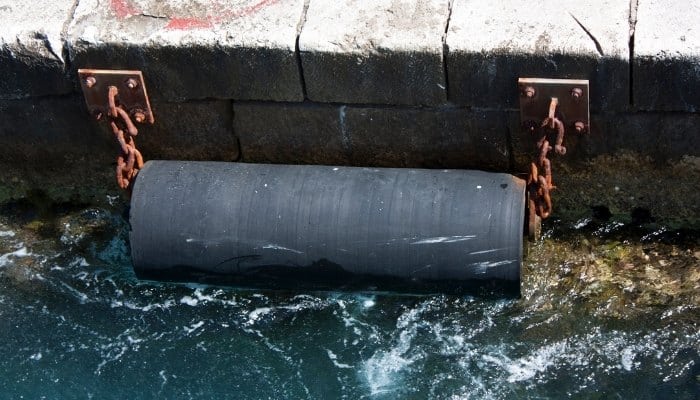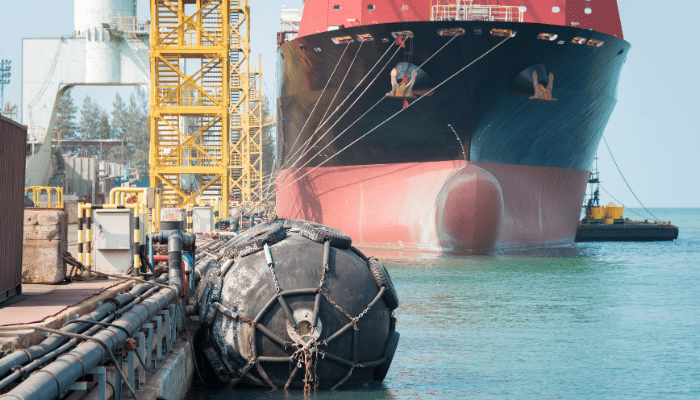How Marine Fenders Are Used For Ship Berthing?
One of the primary factors -external to the ship’s mechanical or electrical systems – that come in to effect while berthing a vessel is the marine fender system. An efficient fender system saves the ship from external damages that would have otherwise occurred to the hull plates or to the berth or jetty, which comes in contact with the steel plates of the ship.
How Ship Berthing is done Using Marine Fenders?
Theoretically speaking, a ship is to be brought at a negligible speed to the berth. A small increase in speed will give rise to an exponential jump in the momentum – which essentially is the product of mass and velocity. For example the displacement tonnage of 10,000 when multiplied by a speed of one knot has half the momentum when multiplied by a speed of two knots. The energy of impact is twice, thrice, four times and so on with every knot of increase of speed.
Now, when it comes to practice the speed always cannot be restricted to bare minimum, owing to certain conditions such as the tides, wind effects, tugs erratic pull, engine failures etc. A good marine fender system can save the day in such exigencies.
Ideally a marine fender system should be cost effective, with low maintenance cost and high durability. The material should be locally available should a case of replacement arise.
While berthing, the navigator of the ship has to consider the amount of berthing energy involved. It is actually a product of various variants such as mass of the vessel or displacement, it’s approach velocity, the added mass co-efficient ( which is the mass of the water that is moving along with the vessel and is suddenly stopped at the point of contact), the eccentricity factor which is the rotational movement generated by a reaction force when the bow or stern comes in contact with the marine fenders at the berth, the berthing configuration factor which is the amount of energy absorbed by the cushion effect of the water between the quay wall of the berth and the approaching vessel, and the softness factor which is the energy absorbed by the deformation of the ship’s hull and the shore marine fender.
Abnormal energy is the energy that exceeds the normal berthing energy when berthing is done in abnormal conditions such as inclement weather, during human or technical error or an ominous combination of all three.
To neutralize this kinetic force imparted by the ship on the pier or berth, some work must be done by the quay wall and the shore structure upon the hull of the ship.
The reactive force of the dock installations increases dramatically, immediately after the impact of the ship’s hull upon it. As a result both the hull and the dock structure deflect according to their respective stiffness.
Herein the marine fender, which is fitted in their interface, becomes active. It deflects and reduces the berthing energy drastically without causing permanent damage to the hull of the vessel or concrete of the berth. Naturally fenders should have high force absorption capacity without exerting a reactive force upon the quay.
Types of Fenders
Now the question arises what is the type of fender to be used in a specific berthing of ship?
Marine fender selection is important as it determines the safety of the personnel, cargo and body of the ship and its equipments. The turn around time of the ship can depend on the quality of the fender. One has to keep in mind the statistics of the heaviest and the largest vessel that reports to the dock before selecting and arranging the marine fender system.
Hollow wooden fenders of yester years are now giving way to various types of rubber marine fender, foam marine fender and pneumatic marine fenders Now fixed rubber fender systems comes in different varieties such as
- Cone fenders
- Cell fenders
- Arch fenders
- Cylindrical fenders
- D type fenders
- Leg fenders
- Dock corner rubber fenders
- Pie-type rubber fenders
Foam fenders contain chemicals such as Ethylene Vinyl Acetate (EVA), which are floatable and low in maintenance cost. A polyurethane spray or elastic-polymer sprays are used over these fenders to create near total wear resistant exterior.
Pneumatic fenders are air filled floating marine fenders which can be fitted on quay wall or ships hull according to the requirement. There are four types of pneumatic marine fenders
- Sling type fender
- Rib type fender
- Rope net fender
- China and tyre net.
Fenders are an integral part of safety system of the ship which reduces the shocks upon the quay or the hull. A wide range or variety of marine fenders is available in the market for different applications. They are not only used for merchant vessels, but also for boats, yachts, and other floating vessels.
The right choice of the marine fender to optimize the cost and the effectiveness is a matter which requires experience and expertise, not to say a thorough overall knowledge of the available varieties, requirements and the theory that goes with it.
Do you have info to share with us ? Suggest a correction
Latest Marine Navigation Articles You Would Like:
Subscribe To Our Newsletters
By subscribing, you agree to our Privacy Policy and may receive occasional deal communications; you can unsubscribe anytime.
Web Stories






















